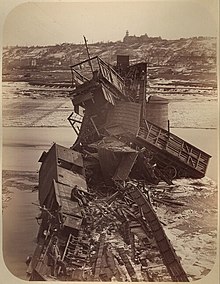Railway accident near Chernivtsi

In the early morning of March 4, 1868, during the railway accident near Chernivtsi , the front section of a train from Chernivtsi to Lemberg fell into the Prut River because the bridge under it collapsed in parts.
Railway bridge near Chernivtsi
The railway line was built under great time pressure during the German War by the Lemberg-Chernivtsi-Jassy Railway Company (LCJE) and opened in 1866. Shortly after the Chernivtsi train station, the railway line to Lemberg crosses the Pruth River. The first bridge was a single-track truss bridge made of cast iron with lower chords made of welded iron according to the Schifkorn system , consisting of four bridge fields with a span of 57.80 m each.
A mixed train ran from Chernivtsi to Lemberg, scheduled departure at 6:30 a.m. On the day of the accident, a second locomotive ran cold behind the train locomotive. The train consisted of ten freight cars, one conductor, one post and four passenger cars. The freight cars were loaded with cattle (130 pigs, 40 oxen) and agricultural products. The passenger cars were occupied by about 40 passengers.
the accident
A few minutes after leaving Chernivtsi, the train passed the bridge over the Prut. When the train reached the last bridge span, it collapsed under the load and fell with the locomotives into the flood-covered river, which was covered with drift ice . After nine of the freight wagons were torn down, the heap of rubble made up of bridge parts and vehicles prevented the remaining wagons from falling.
Since the passenger cars ran behind the freight cars and did not crash, no passengers were harmed. The engine driver and stoker jumped out of the crashing locomotive and were injured, exhausted and dangerously hypothermic to save themselves from the water. A train crew man was missing and was believed to have died in the accident.
Consequences of the accident
The investigation report into the accident named several causes. The construction of the lower chords was too weak, so that the welding iron used was stressed far beyond the permissible level. The construction and maintenance of the bridge was also poor. These defects, together with the high load on the two locomotives of the train involved in the accident, led to the bridge collapsing.
Another finding from the accident was that the Schifkorn system was fundamentally unsuitable for railway bridges. In addition to the one that had collapsed, there were three other bridges of this type on the Lemberg – Chernivtsi line. All superstructures on these four bridges were demolished shortly after the accident and replaced with new constructions.
Other railway companies also drew conclusions from the accident and in the years up to 1895 replaced the superstructures of the approximately 110 bridges built according to the Schifkorn system with superstructures of newer construction.
Individual evidence
- ↑ Hans Pottgießer: Bridges from two centuries . Basel 1985, ISBN 978-3-0348-6663-7
- ^ JJ: Interrupted train journey . In: The Gazebo . Issue 15, 1868, pp. 236 ( full text [ Wikisource ]).
Coordinates: 48 ° 18 '43.4 " N , 25 ° 55' 22.9" E
